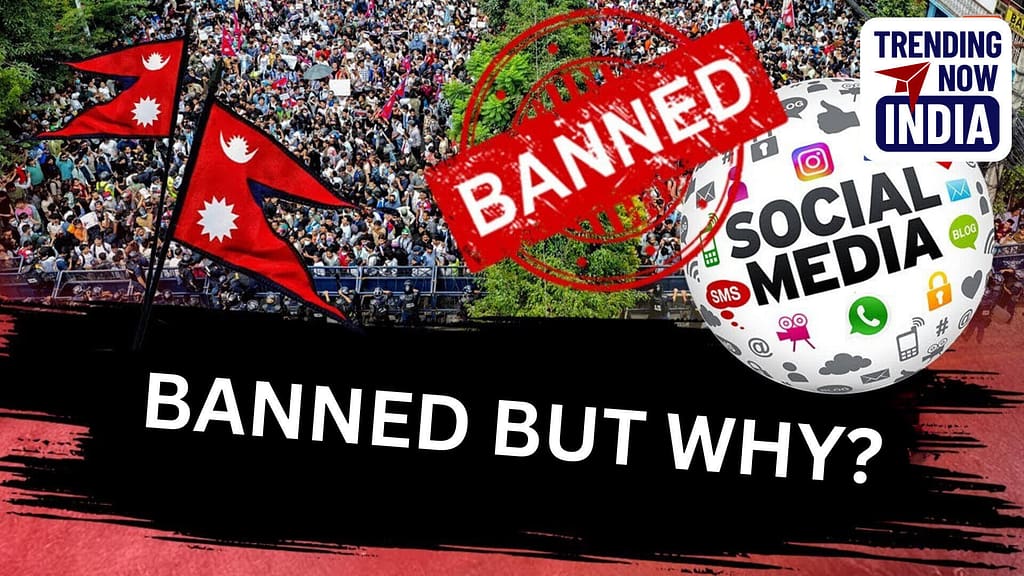
Nepal Social Media Ban 2025
Nepal social media ban has become one of the most controversial digital policy decisions of 2025, affecting millions of users and sparking unprecedented youth-led protests across the Himalayan nation. The government’s decision to block 26 major social media platforms, including Facebook, Instagram, WhatsApp, and YouTube, has created a digital divide that extends far beyond simple internet restrictions. This sweeping social media ban in Nepal represents a critical moment in the country’s digital evolution, highlighting the complex intersection of regulatory compliance, digital rights, and economic implications in an increasingly connected world.

Crowd with Nepalese flags and a banned stamp on social media icons representing the social media ban in Nepal
Understanding the Nepal Social Media Ban: What Happened and Why ?
The Immediate Trigger: Registration Requirements
The Nepal social media ban was implemented on September 4, 2025, following a seven-day ultimatum issued by the Ministry of Communications and Information Technology. The government required all social media platforms to register under the Directive for Regulation of Social Media Use, 2080, which mandated several key compliance measures.
Under this directive, platforms were required to establish a registered office in Nepal, appoint a local contact person, and implement grievance redressal mechanisms. The deadline expired on September 3, 2025, when none of the major global platforms – including Meta (Facebook, Instagram, WhatsApp), Alphabet (YouTube), X (formerly Twitter), Reddit, or LinkedIn – had submitted registration applications.
Legal Foundation: Supreme Court Mandate
The Nepal social media ban stems from a Supreme Court ruling in a contempt of court case (Case No. 080-8-0012), which directed the government to ensure that no unregistered social media platform operates in the country. The court’s verdict specifically stated that “online and social media platforms of domestic or foreign origin should be mandatorily registered with the competent authority before operation”.
This legal framework was further reinforced by a nine-member extended bench of the Supreme Court, led by then-chief justice Bishowambhar Prasad Shrestha, which ruled that social media platforms should be subjected to monitoring and supervision by competent authorities.
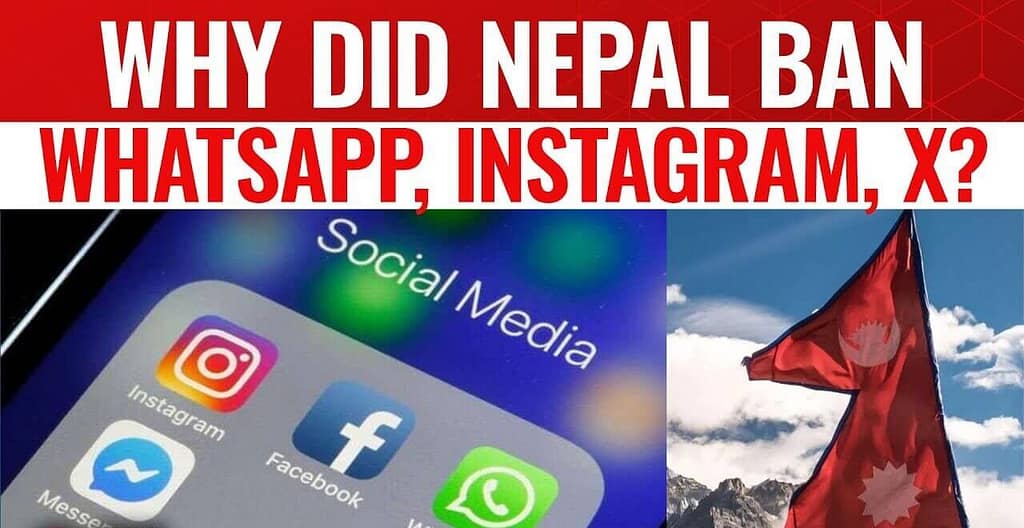
Visual representation of Nepal’s ban on WhatsApp, Instagram, and X social media platforms with the Nepali flag illustrating the country context
The Massive Scale: 26 Platforms Affected by Nepal’s Social Media Ban
Major Platforms Blocked
The Nepal social media ban encompasses a comprehensive list of 26 platforms that dominate the country’s digital landscape. The blocked platforms include:
- Meta Platforms: Facebook, Instagram, WhatsApp, Messenger
- Google Services: YouTube
- Communication Apps: X (Twitter), LinkedIn, Signal, Threads
- Entertainment Platforms: Snapchat, Reddit, Discord, Pinterest
- International Apps: WeChat, Quora, Tumblr, Clubhouse, Line, IMO
- Regional Apps: Zalo, Soul, Hamro Patro
Platforms Still Operating
Notably, several platforms remained operational because they had already completed the registration process or were in the approval pipeline:
- TikTok: Registered in November 2024 after fulfilling regulatory requirements
- Viber: Compliant with registration requirements
- Communication Apps: Wetalk, Nimbuzz, Popo Live
- Under Review: Telegram and Global Diary
The Human Impact: How Nepal’s Social Media Ban Affects Millions
Demographics and Usage Statistics
Nepal’s social media ban affects a significant portion of the population, with social media penetration reaching substantial levels across the country. According to DataReportal’s 2024 figures, Nepal had 13.5 million active Facebook users, representing approximately 43.5% of the total population. The ban also impacts 3.6 million Instagram users, 10.85 million Facebook Messenger users, and 1.5 million LinkedIn users.
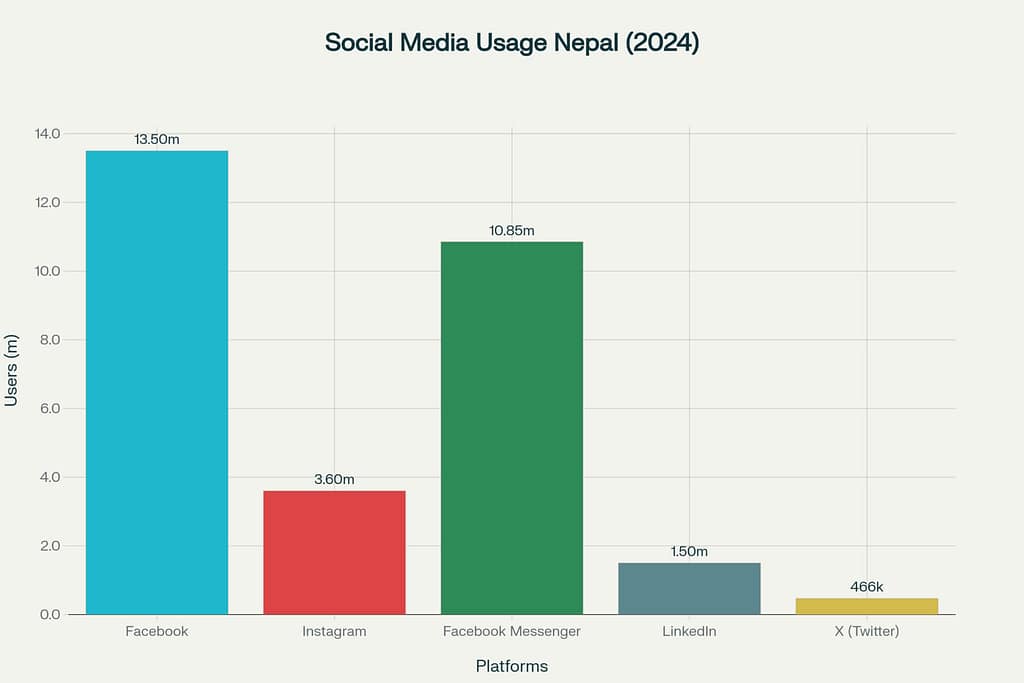
Social Media Platform Usage Statistics in Nepal (2024)
The demographic breakdown reveals that young people aged 16-24 constitute approximately 55% of Nepal’s social media users, making them the most affected group by the Nepal social media ban. This age group’s heavy reliance on digital platforms for communication, education, and economic opportunities makes the ban particularly impactful.
Economic Consequences for Families and Businesses
The Nepal social media ban has severe economic implications, particularly affecting the country’s substantial migrant worker population. With personal remittances accounting for 33.06% of Nepal’s GDP according to World Bank data, communication platforms like WhatsApp, Messenger, and Viber serve as crucial links between families separated by migration.
Small businesses and entrepreneurs who relied heavily on social media for marketing and sales have been forced to rapidly adapt their strategies. The timing of the ban, coinciding with Nepal’s largest festive season leading up to Dashain, has disrupted business operations when companies typically generate 30% of their annual revenues
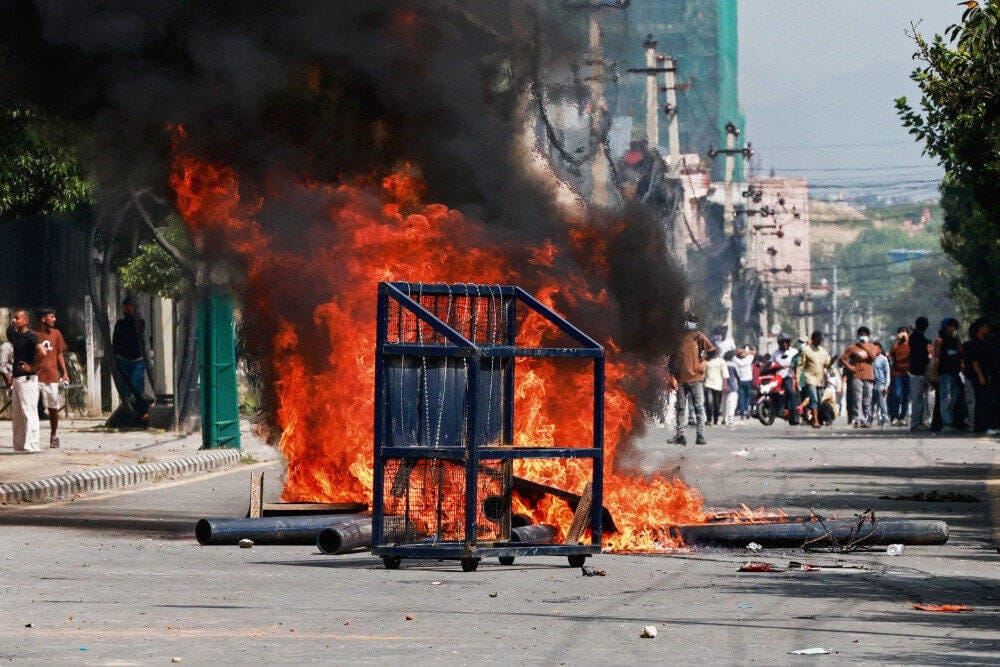
The Explosive Response: Gen Z Protests Rock Nepal
The Scale of Civil Unrest
The Nepal social media ban triggered unprecedented protests, primarily led by Generation Z demonstrators who took to the streets of Kathmandu on September 8, 2025. What began as peaceful demonstrations quickly escalated into violent confrontations, resulting in at least 19 deaths and over 100 injuries according to various reports.
The protests, dubbed a “Gen Z revolution,” saw thousands of young people marching from Maitighar Mandala toward Nepal’s Parliament building, carrying national flags and placards with messages such as “Shut down corruption, not social media” and “Youth against corruption”.
Beyond Social Media: Corruption and Nepotism
While the Nepal social media ban served as the immediate trigger, the protests revealed deeper issues of systemic corruption and nepotism. The #NepoKids and #NepoBaby campaigns that trended on platforms like TikTok and Reddit highlighted the stark contrast between the lavish lifestyles of politicians’ children and the struggles of ordinary Nepalis.
Protesters displayed signs reading, “The leaders’ children return from abroad with Gucci bags, the people’s children in coffins,” referring to the severe poverty and high youth unemployment (19.2% among those aged 15-29) that drives many young Nepalis to work as mercenaries abroad.
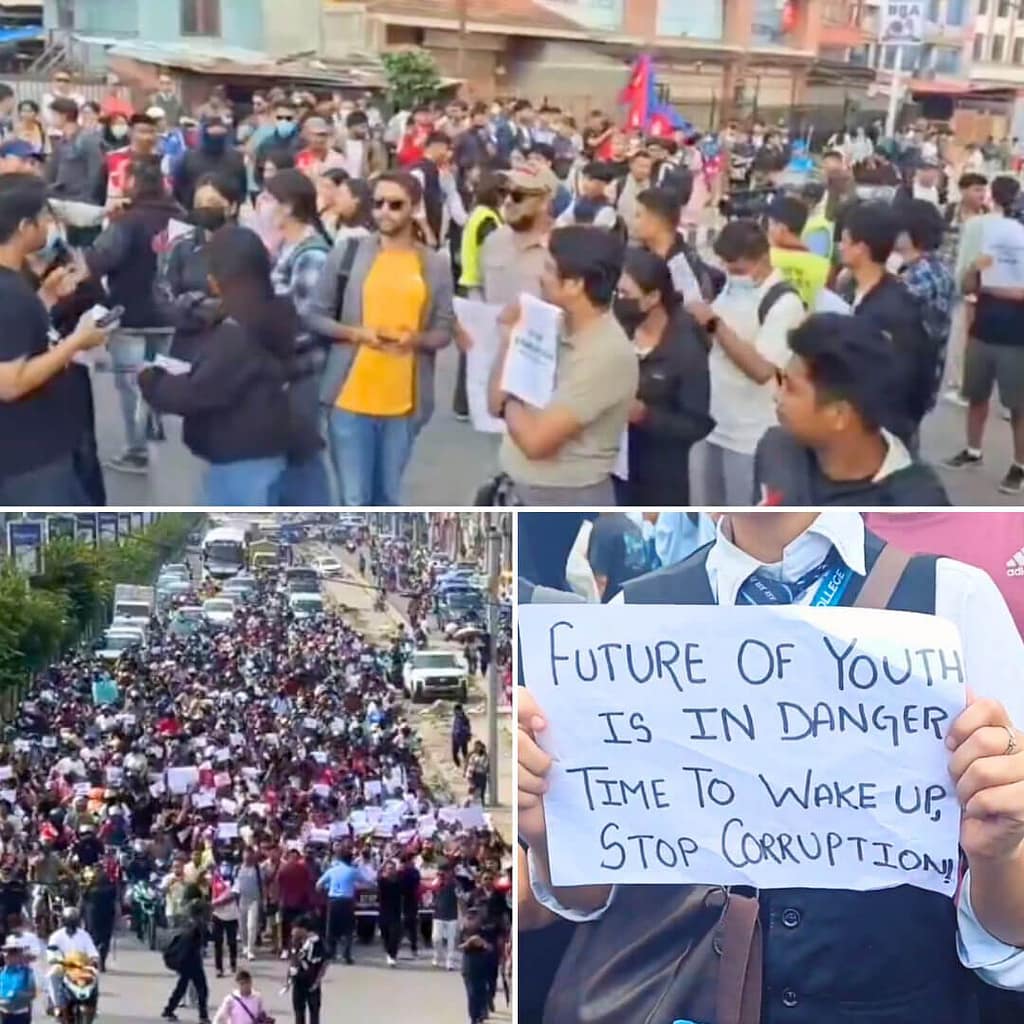
Youth-led protest in Nepal opposing social media ban with signs demanding action against corruption and warning about the future of youth
Government’s Defense: National Sovereignty vs. Digital Rights
Official Justifications
Prime Minister KP Sharma Oli has consistently defended the Nepal social media ban as a matter of national sovereignty and regulatory compliance. In a speech addressing the Communist Party convention, Oli declared, “The independence of the nation is greater than the loss of jobs of a handful of individuals. How can it be acceptable to defy the law, disregard the constitution, and disrespect national dignity, independence, and sovereignty?”
Minister of Communications and Information Technology Prithvi Subba Gurung emphasized that the government made repeated requests to social media platforms to register, but these requests were ignored. Officials argue that the Nepal social media ban is not about restricting platforms but ensuring they operate within the legal framework and contribute to the national economy through proper taxation.
Regulatory Precedents
The Nepal social media ban follows previous instances of platform restrictions in the country. TikTok was initially banned in August 2024 for “disrupting social harmony” but was reinstated in November 2024 after ByteDance agreed to comply with local regulations. Similarly, Telegram was banned in July 2025 due to its alleged use in online fraud and money laundering activities.
International Context: Global Trend of Social Media Regulation
Worldwide Regulatory Movements
The Nepal social media ban occurs within a broader global context of increasing social media regulation. Governments across the United States, European Union, India, China, and Australia are implementing stricter oversight measures due to concerns about misinformation, data privacy, online safety, and national security.
However, critics argue that Nepal’s approach is particularly restrictive compared to other regulatory frameworks. Unlike countries that implement gradual compliance measures or financial penalties, Nepal opted for immediate platform shutdowns, creating significant disruption for users and businesses.
Digital Rights Concerns
International press freedom organizations, including the Committee to Protect Journalists (CPJ) and Access Now, have criticized the Nepal social media ban as overbroad censorship that threatens freedom of expression and press freedom. These organizations argue that the ban could harm Nepal’s international reputation and discourage foreign investment in the country’s emerging IT sector.
Economic Implications: The True Cost of Nepal’s Social Media Ban
Impact on Digital Economy
The Nepal social media ban poses significant risks to the country’s growing digital economy and IT outsourcing industry. Nepal’s IT sector has been contributing increasingly to GDP, with over 50 companies employing more than 200 people each and 10 firms with over 500 employees. These companies rely on stable digital infrastructure and policy predictability to compete in global markets.
The advertising and marketing industry faces particular challenges, with agencies reporting that nearly 30% of annual business volumes are generated during the festive season when social media campaigns are crucial. The ban forces companies to rely more heavily on traditional media channels, potentially increasing marketing costs and reducing reach.
Tourism and Service Sectors
Nepal’s tourism industry, which heavily depends on social media for destination marketing and visitor engagement, faces potential long-term consequences from the social media ban. The visibility and promotion of tourism destinations through platforms like Instagram and Facebook play crucial roles in attracting international visitors.
Service providers and internet companies also report significant revenue losses. When TikTok was previously banned, telecom operator Ncell lost approximately Rs 600 million in monthly revenues, and the industry collectively lost around Rs 5 billion over nine months.
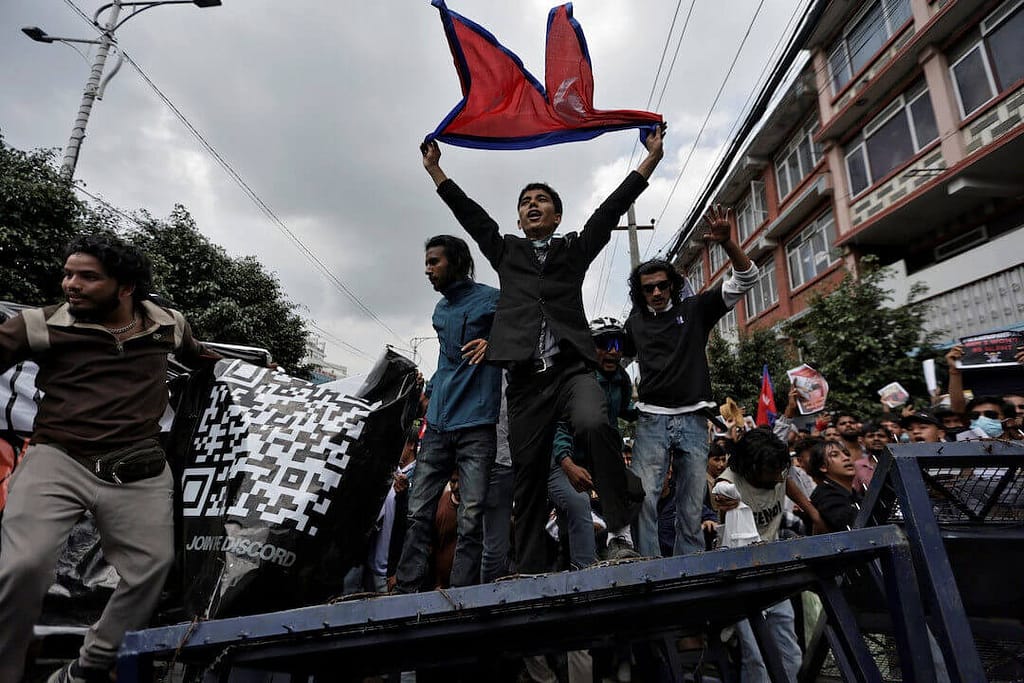
The Role of Alternative Platforms and VPN Usage
Shift to Available Platforms
Following the Nepal social media ban, users rapidly migrated to available platforms, causing significant traffic spikes on TikTok and Viber. This migration demonstrates the adaptability of digital users but also highlights the concentration of activity on fewer platforms, potentially creating new dependencies and regulatory challenges.
TikTok, in particular, has experienced unprecedented growth as users and businesses pivot their strategies to focus on short-form video content and algorithmic reach. The platform’s compliance with Nepal’s regulatory requirements has positioned it as a primary communication and marketing channel during the ban period.
VPN Usage and Security Concerns
The government has cautioned users against relying on “unsafe, unofficial, and potentially risky virtual private networks (VPNs)” to access blocked platforms. However, reports suggest widespread VPN adoption as users seek to maintain access to familiar platforms and services.
This shift to VPN usage raises concerns about cybersecurity, data privacy, and the effectiveness of the Nepal social media ban in achieving its stated regulatory objectives. The technical challenges of enforcing comprehensive platform blocks in the digital age highlight the complexity of modern internet governance.
Legal Framework: Understanding the Social Media Act 2081
Comprehensive Regulatory Structure
The proposed Social Media Act 2081, registered at the National Assembly on January 28, 2025, provides a comprehensive framework for regulating social networking platforms in Nepal. The act establishes detailed licensing procedures, content monitoring mechanisms, and penalty structures for non-compliance.
Key provisions of the act include mandatory licensing for platform operators, establishment of local grievance handling mechanisms, and requirements for user identity verification. The legislation also empowers authorities to restrict platform operations and impose fines ranging from NPR 500,000 to NPR 1,500,000 for content-related violations.
Enforcement Mechanisms
The act designates multiple authorities as enforcement agencies, including Nepal Police, Nepal Telecommunications Authority, Press Council, Department of Information and Broadcasting, and Advertisement Board. This multi-agency approach aims to ensure comprehensive oversight but also raises questions about coordination and consistency in enforcement.
The legislation requires platforms to comply with directives to remove content deemed harmful to national security, territorial integrity, or social harmony. Licensed entities must also provide user data to relevant authorities for investigations and ensure all financial transactions are processed through the banking system.
Future Implications: What’s Next for Nepal’s Digital Landscape?
Potential Resolution Paths
Government spokesperson Prithvi Subba Gurung has indicated that discussions are underway to reconsider the Nepal social media ban, stating that “the government’s decisions are not more important than the lives of the people”. This suggests potential flexibility in the government’s position, particularly given the scale of public opposition and international criticism.
Several platforms have initiated communication with Nepali authorities regarding registration procedures. X (Twitter) has contacted officials from its Singapore regional office, while domestic platform Hamro Patro has completed the registration process and been reactivated.
Long-term Regulatory Evolution
The Nepal social media ban may represent an initial phase in a broader regulatory evolution rather than a permanent policy position. Historical precedents with TikTok and Telegram demonstrate that negotiated compliance solutions are possible when platforms engage constructively with government requirements.
The development of clear, transparent regulatory frameworks that balance platform accountability with digital rights will be crucial for Nepal’s digital future. The country’s experience with the social media ban may inform more nuanced approaches to digital governance that protect both national interests and user freedoms.
Young Nepali protestors demonstrate energetically in Kathmandu against the social media ban, holding a flag and banners amid an urban protest setting
Lessons Learned: Balancing Regulation and Digital Rights
The Importance of Stakeholder Engagement
The Nepal social media ban highlights the critical importance of stakeholder engagement in digital policy development. The lack of consultation with civil society, business communities, and digital rights organizations contributed to the abrupt implementation and subsequent backlash.
Future regulatory initiatives would benefit from inclusive dialogue processes that consider the diverse impacts of digital policies on different segments of society. This approach could help develop more balanced and sustainable regulatory frameworks.
Graduated Compliance Approaches
International best practices suggest that graduated compliance approaches, involving warnings, financial penalties, and temporary restrictions before complete platform shutdowns, may be more effective than immediate bans. Such approaches allow for dialogue and adjustment while maintaining regulatory pressure for compliance.
The Nepal social media ban experience demonstrates that abrupt policy changes can create significant economic and social disruption, potentially undermining the very goals the regulations seek to achieve.
Conclusion: Nepal’s Digital Crossroads
The Nepal social media ban represents a pivotal moment in the country’s digital development, highlighting fundamental tensions between regulatory sovereignty and digital rights. While the government’s desire to ensure platform compliance and protect national interests is understandable, the implementation approach has created significant challenges for users, businesses, and the broader economy.
The unprecedented scale of youth-led protests demonstrates that digital policy decisions cannot be made in isolation from public sentiment and social realities. The ban has revealed deeper issues of corruption, inequality, and generational disconnect that extend far beyond social media regulation.
As Nepal navigates this digital crossroads, the path forward will require careful balancing of regulatory objectives with practical considerations of economic impact, user rights, and social stability. The resolution of the Nepal social media ban will likely set important precedents for digital governance not only in Nepal but across South Asia and other developing markets grappling with similar regulatory challenges.
The ultimate test will be whether Nepal can develop a regulatory framework that ensures platform accountability while preserving the digital freedoms and economic opportunities that have become essential to modern society. The outcome of this balance will shape Nepal’s digital future and its position in the global digital economy for years to come.
People Also Ask (PAA)
Q: Why did Nepal ban social media platforms in 2025?
A: Nepal banned 26 social media platforms because they failed to register with the Ministry of Communications and Information Technology within a seven-day deadline. The ban was implemented following a Supreme Court directive requiring all platforms to establish local offices and compliance mechanisms.
Q: Which social media platforms are banned in Nepal?
A: The banned platforms include Facebook, Instagram, WhatsApp, YouTube, X (Twitter), LinkedIn, Snapchat, Reddit, Discord, Pinterest, Signal, Threads, WeChat, Quora, Tumblr, and others. TikTok and Viber remain operational as they completed registration requirements.
Q: How many people died in Nepal’s social media ban protests?
A: At least 19 people died and over 100 were injured during the violent protests against Nepal’s social media ban, primarily in clashes between Gen Z demonstrators and police forces in Kathmandu.
Q: Can people in Nepal still access banned social media sites?
A: While the platforms are officially blocked, some users report accessing them through VPNs, though the government has warned against using “unsafe and risky” VPN services. The ban’s effectiveness varies across different regions and internet service providers.
Q: Will Nepal lift the social media ban?
A: Government officials have indicated discussions are underway to reconsider the ban, with Communications Minister stating that “government decisions are not more important than people’s lives.” Some platforms like X have initiated registration discussions.
Read this also: https://trendingnowindia.in/khyber-pakhtunkhwa-cricket-ground-blast/






Looks like the protests in Nepal are gaining huge attention right now. The people seem really determined to raise their voices, and the government’s response will be crucial in shaping what comes next. ✊🇳🇵 #NepalProtests #VoiceOfThePeople